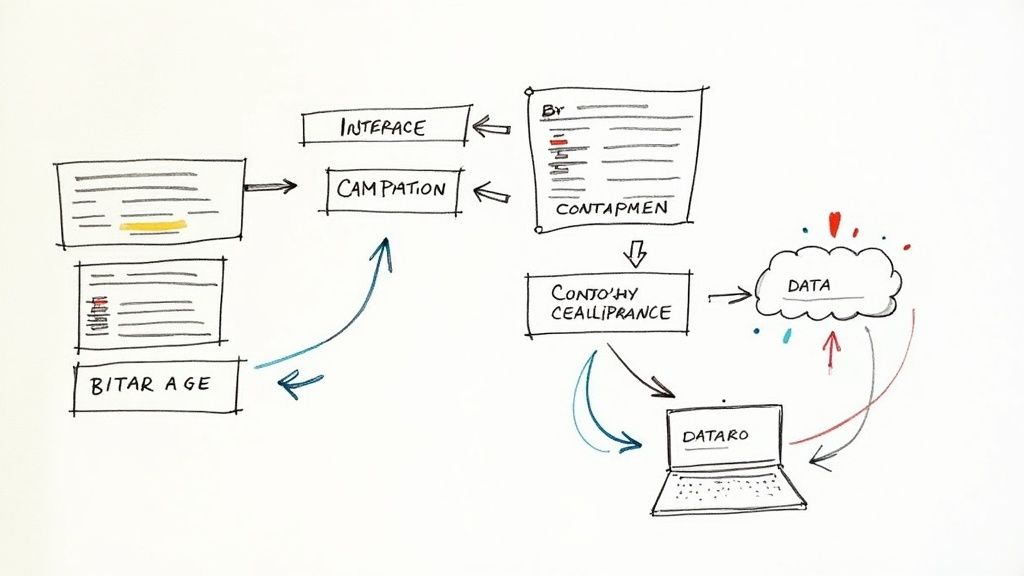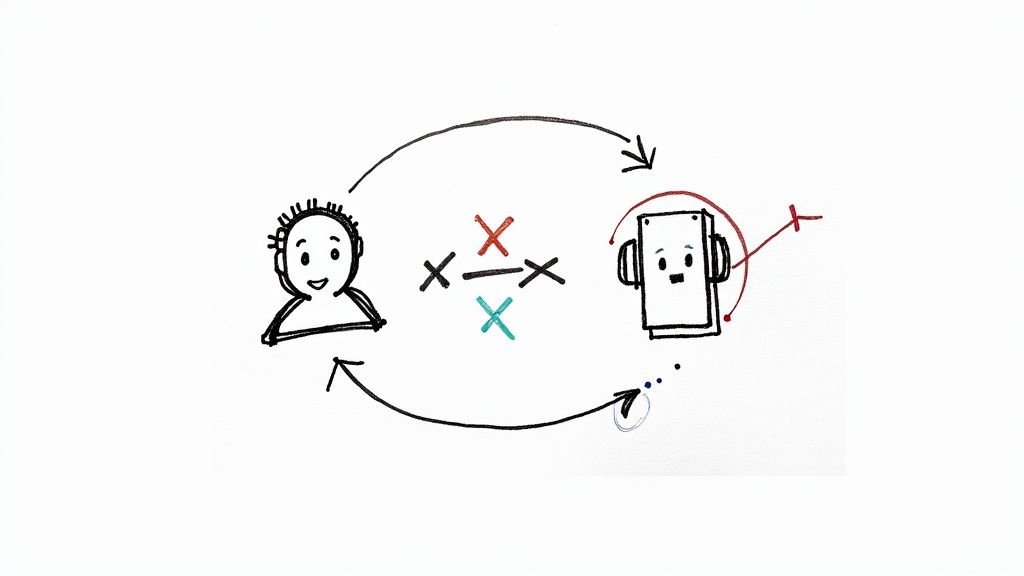How to Train an AI Chatbot: A Step-by-Step Guide
Understanding the AI Chatbot Training Landscape
Building an effective AI chatbot requires mastering several key technical and strategic elements. Success comes from a deep understanding of how these systems learn and develop, along with practical knowledge of implementation methods that deliver real results.
Key Differences Between Rule-Based and AI-Powered Chatbots
The chatbot world splits into two main categories - each with distinct capabilities and limitations. Basic rule-based chatbots follow simple if-then logic patterns, similar to a decision tree. For instance, if a customer asks about store hours, the bot provides a pre-written response. While straightforward to set up, these bots can only handle basic, predictable interactions.
AI-powered chatbots work quite differently. Built on advanced language models and trained on massive text datasets, they can understand natural conversation, pick up on context clues, and respond more like a human would. This means they can handle complex scenarios like walking a customer through troubleshooting steps or suggesting products based on detailed preferences - tasks that would overwhelm a rule-based system.
Balancing Computational Resources and Training Quality
Training sophisticated AI chatbots demands significant computing power. For example, ChatGPT processed over 300 billion words during its training. But raw data volume isn't everything - quality and relevance matter more. Just as you wouldn't want to learn from incorrect information, chatbots need carefully selected, accurate training data to perform well.
Good training data requires extensive preparation. Teams need to clean out errors and inconsistencies while also expanding their datasets through techniques like data augmentation. This creates more examples for the chatbot to learn from, helping it handle a broader range of real user conversations effectively.
Navigating the Pitfalls of Chatbot Training
Several common issues can seriously impact chatbot performance. Poor data preparation tops the list - if training data doesn't match how users actually talk, the chatbot will struggle. For example, training only on formal business language leaves the bot confused by casual phrases and common slang.
Another key mistake is treating chatbot training as a one-time task. Like any customer service system, chatbots need regular updates and improvements. User needs change, language evolves, and new issues arise. Regular monitoring helps identify where the chatbot needs additional training or adjustments to stay effective.
Creating truly useful AI chatbots means carefully managing these various elements. Success comes from maintaining high-quality data, using resources wisely, and committing to ongoing improvements. This focused approach helps ensure chatbots can handle real-world conversations and provide genuine value to users.
Mastering the Art of Training Data Preparation
The success of AI chatbots depends heavily on the quality of their training data. Just as students need good study materials to learn effectively, chatbots need carefully prepared data to function well. Let's explore the key steps in creating training data that leads to better chatbot performance.
Collecting Relevant Conversation Data
The first priority is gathering real conversations that match your chatbot's intended purpose. If you're building a customer service chatbot, you'll want to collect actual support ticket exchanges, chat logs, and common customer questions. Focus on authentic examples - like questions about product features, shipping times, return policies, and problem resolution. By using genuine conversations, your chatbot learns to handle the types of interactions it will encounter in real situations.
Cleaning and Preprocessing the Data
Raw conversation data needs careful refinement before it can be used for training. This involves removing duplicate entries, fixing spelling and grammar errors, and standardizing how the text is formatted. Think of it like sorting through old files - you keep the valuable information while removing outdated or irrelevant content. The goal is to create clean, consistent data that helps your chatbot learn the right patterns without getting confused by mistakes or inconsistencies in the training examples.

Organizing and Structuring for Effective Training
Once the data is clean, it needs to be organized in a way that makes sense to the AI. This means grouping similar conversations together and labeling them based on what the user was trying to accomplish. For example, you might create categories for product questions, shipping inquiries, and technical support issues. Each conversation should clearly show what the user asked and what the ideal response should be. To expand your dataset, you can create variations of existing conversations while keeping the core meaning intact.
The Impact of Data Quality on Chatbot Performance
The effort put into preparing training data directly affects how well your chatbot performs. Poor quality data leads to confused responses and frustrated users. But when trained on carefully prepared examples, chatbots can handle complex conversations naturally and provide helpful answers. The key is maintaining high standards throughout the data preparation process. You might find it helpful to review How to master sitemaps to better organize your website content. Taking time to properly prepare training data is what separates chatbots that truly help users from those that fall short of expectations.
Implementing Real-World Training Strategies
Getting your AI chatbot to perform well requires more than just data - you need effective training strategies that work in practice. Like teaching a student, successful chatbot training combines proven methods with careful monitoring and adjustment. Let's explore the key approaches that consistently deliver results when training chatbots for real business use.
Supervised Learning: A Foundation for Chatbot Training
At its core, supervised learning teaches chatbots by example. The process involves showing the AI model pairs of user inputs and ideal responses - similar to a teacher providing practice problems with answers. For instance, when a user asks "What are your store hours?", the model learns to respond with "Our store is open from 9am to 5pm, Monday through Friday." By processing thousands of these examples, the chatbot begins to understand how to match questions with appropriate answers. This method works particularly well for common customer service scenarios and specific tasks. It's straightforward to implement and creates a strong base for more advanced training.
Reinforcement Learning: Enhancing Conversational Fluency
While supervised learning creates good baseline behaviors, reinforcement learning helps chatbots improve through practice and feedback. The process rewards helpful responses and discourages poor ones, much like how we learn from our successes and mistakes. Take a chatbot suggesting restaurants - when users respond positively to recommendations, that reinforces the chatbot's decision-making. But if users dislike the suggestions, the negative feedback helps the chatbot adjust its approach. This back-and-forth helps chatbots develop more natural conversation skills and better judgment than supervised learning alone can provide.

Optimizing Your Training Process: Metrics and Mistakes to Avoid
Success requires keeping close track of how well your chatbot is learning. Key performance indicators include accuracy (overall correct responses), precision (accuracy of positive predictions), recall (ability to find relevant cases), and F1-score (balance of precision and recall). These metrics help spot where the chatbot needs improvement. However, simply adding more training data isn't always the answer. Like a student needs focused practice on weak areas, chatbots need carefully selected examples that address specific gaps. Watch out for common problems like overfitting, where the bot memorizes training examples but struggles with new situations. Also critical is ongoing training - user needs change over time, so regular updates help keep the chatbot's skills fresh and relevant.
By applying these practical training approaches, tracking the right metrics, and steering clear of typical pitfalls, you can build a chatbot that truly helps your users. This methodical training process sets up the next important step: giving your chatbot a distinct personality through fine-tuning that matches your brand and goals.
Crafting Personality and Purpose Through Fine-Tuning
Once you've established solid training foundations, the next step is giving your chatbot a unique personality and clear purpose through fine-tuning. This process moves beyond basic response capabilities to create an engaging conversational partner that authentically represents your brand voice and values. By refining the pre-trained model, you can shape how your chatbot communicates and interacts with users.
Defining Your Chatbot's Persona
Your chatbot needs a distinct personality, just like any customer service representative. Think carefully about the type of interaction style that fits your brand - will your chatbot be warm and helpful, casual and funny, or professional and direct? A gaming company's chatbot might use playful language and pop culture references, while a bank's chatbot should maintain a more serious, trustworthy tone. The key is picking a personality that resonates with your specific audience and sticking to it consistently.
Maintaining Consistent Interaction Styles
Beyond personality traits, fine-tuning lets you control practical aspects of how your chatbot communicates. This includes details like typical response length, use of casual elements like emojis, and overall writing style. For example, if you want your chatbot to give brief, clear answers, it should do this reliably rather than sometimes providing long-winded responses. Users get frustrated when a chatbot's communication style changes unpredictably. Good fine-tuning creates a smooth, dependable experience that builds trust over time.
Tailoring Responses for Specific Industries
Each industry comes with its own communication needs. A healthcare chatbot must show empathy and handle sensitive topics carefully, while a retail chatbot focuses more on product details and purchase assistance. Through fine-tuning, you can teach your chatbot the right terminology, information sources, and communication approaches for your field. This might include loading industry databases, setting appropriate response protocols, or adding specialized knowledge that helps the chatbot serve your particular audience effectively.
Scaling Personality While Maintaining Accuracy
As your chatbot handles more conversations with a growing user base, keeping responses both accurate and on-brand becomes challenging. The chatbot will face an expanding variety of questions and scenarios. Regular testing and monitoring help catch any issues with response quality or consistency early on. Much like human staff need ongoing coaching, your chatbot requires continuous fine-tuning adjustments to stay effective. By maintaining strong oversight of both personality and accuracy, you can build a chatbot that consistently delivers value while staying true to your brand voice.
Building a Robust Testing and Optimization Framework
Setting up proper testing and optimization processes is essential once you've established your chatbot's core personality and purpose. This phase goes beyond basic functionality checks to verify that your chatbot consistently delivers value and creates positive interactions with users. A systematic approach to testing gives you the data and insights needed to deploy with confidence.
Why Testing and Optimization Matter
Like a chef sampling a dish throughout preparation, you need to continually evaluate and fine-tune your chatbot. While initial training creates a foundation, actual user conversations rarely follow a predictable script. People phrase questions in unexpected ways, bring up topics outside the training scope, or occasionally try to challenge the system's limits. Through thorough testing, you can spot these scenarios early and make improvements. A clothing store's chatbot, for example, might discover gaps in its knowledge when customers ask detailed questions about fabric care that weren't in the original training data. Finding and fixing these limitations prevents frustrated customers later.
Combining Automated and Human Evaluation
The most effective testing strategy uses both automated tools and human reviewers to their strengths. Automated tests can rapidly check technical performance, response consistency, and speed across thousands of simulated conversations. This helps identify patterns and potential issues that would be impossible to spot manually. But machines can't fully grasp the nuances of human dialogue. That's where human testers come in - they evaluate the natural flow of conversation, emotional intelligence, and ability to handle complex exchanges. Their feedback on tone, clarity, and overall experience completes the performance picture.
Key Metrics for Measuring Success
Success requires tracking more than just basic accuracy. Comprehension shows how well the chatbot understands user intent despite variations in how questions are asked. Resolution measures whether users get the help they need. Engagement indicates if conversations feel natural and satisfying. Retention tracks if users come back to use the chatbot again. Together with direct user feedback, these metrics reveal how well your chatbot performs in real-world use. You might be interested in: How to master sitemaps to learn more about organizing content to improve bot training.
Continuous Improvement Through Iterative Optimization
Training a chatbot is an ongoing process, not a one-time task. User needs shift, language changes, and business goals evolve. This makes it vital to keep optimizing over time. Regular analysis of test results and user feedback helps identify areas needing additional training or adjustments. By continuously testing, measuring results, and making refinements, your chatbot becomes more capable and useful. Tracking these improvements also provides valuable insights to guide future development and create better user experiences. This steady optimization ensures your chatbot keeps delivering value as user needs change.

Scaling Success: From Prototype to Production
Moving from a prototype to a full-scale AI chatbot requires careful planning to manage growth while maintaining performance. Like expanding a small business, you need to think about handling more customers, keeping service quality high, and watching your budget. Let's explore the key steps to scale your chatbot successfully.
Handling Increased Conversation Loads
When more users start engaging with your chatbot, the system needs to handle many conversations smoothly. Think of it like a busy restaurant during peak hours - you need a way to serve everyone promptly without compromising quality. Load balancing helps by spreading conversations across multiple chatbot instances, similar to having several servers handle different tables. Beyond that, making your code more efficient and using smart data storage techniques helps your chatbot respond quickly even during busy periods.
Implementing Systematic Improvement Cycles
Getting better over time requires paying attention to how your chatbot performs. Just as sports teams review game footage, you need to track key metrics like how quickly your chatbot handles requests and how satisfied users are with the responses. This data shows you what's working well and what needs work. For example, if users often need to repeat questions about shipping policies, you know to improve training in that area. Regular monitoring and updates keep your chatbot sharp and useful.
Maintaining Conversation Quality at Scale
As your chatbot handles more conversations, keeping responses consistently good becomes crucial. Regular quality checks help catch and fix issues early - just like how restaurants conduct food quality inspections to maintain standards. Review conversation logs, ask users for feedback, and use tools to spot potential problems. Make it easy for users to tell you how the chatbot is doing through quick surveys or feedback buttons. This helps you understand what users really need and how to serve them better.
Controlling Costs While Maintaining Performance
Smart budget management helps you grow without breaking the bank. Cloud services, data storage, and system upkeep all cost money, but there are ways to keep expenses reasonable. Using serverless computing lets you pay only when your chatbot is actually talking to users - like renting equipment only for the days you need it instead of buying it outright. Look into different pricing plans from cloud providers - some offer better deals for long-term commitments, while others let you pay as you go. Keep track of when and how people use your chatbot to find the most cost-effective setup that still delivers great service.

Want to improve how your business connects with customers? Start building your own custom chatbot with Sitebot. Our platform makes it simple to create, train and launch chatbots that work for your specific needs. Visit https://sitebot.co to try it free today.


